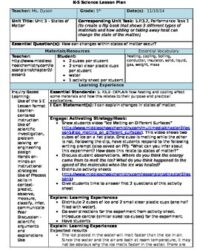The world of science education is constantly evolving, seeking innovative ways to engage students and deepen their understanding of complex concepts. Among the most widely embraced and effective frameworks is the 5E instructional model. This student-centered approach transforms traditional teaching into a dynamic, interactive experience, guiding learners through a systematic process of discovery and knowledge construction. It moves beyond rote memorization, fostering critical thinking and problem-solving skills that are essential for future scientists and informed citizens alike.
Adopting the 5E model can significantly enhance how scientific principles are taught and learned. However, implementing it effectively often requires a structured approach. That’s where a well-designed template comes in handy. A comprehensive framework ensures that each phase of the 5E model is adequately addressed, promoting a cohesive and impactful learning journey for every student. Let’s delve into how this powerful model works and how you can leverage a template to streamline your science lesson planning.
Unpacking the Power of the 5E Instructional Model in Science
The 5E model, standing for Engage, Explore, Explain, Elaborate, and Evaluate, provides a sequential yet flexible framework for designing science lessons. Each “E” represents a phase in the learning cycle, building upon the previous one to create a comprehensive educational experience. This cyclical approach ensures that students are not just passive recipients of information but active participants in their own learning. It starts by sparking curiosity and moves through hands-on investigation, conceptual understanding, application, and finally, assessment of learning.
Engaging Young Minds: The First Steps
The “Engage” phase is all about capturing students’ attention and activating their prior knowledge. This is where you introduce a concept, pose a question, or present a phenomenon that hooks them into the lesson. It’s about creating a sense of wonder and setting the stage for inquiry. A compelling demonstration, a thought-provoking video, or a relatable real-world problem can effectively kick off this phase, making students eager to learn more. Following this, the “Explore” phase is where students get hands-on. They work individually or in groups to investigate the concept through direct experience, experiments, or observations. This is their opportunity to collect data, identify patterns, and begin forming their own conclusions before formal instruction. The teacher acts as a facilitator, guiding their exploration without giving away answers, encouraging independent discovery.
Deepening Understanding: From Explanation to Elaboration
Once students have had the chance to explore, the “Explain” phase provides an opportunity for them to verbalize their findings and for the teacher to introduce formal concepts, definitions, and explanations. This is where scientific vocabulary is introduced, and students connect their observations from the Explore phase to the scientific principles being taught. It’s a collaborative process where students share what they’ve learned, and the teacher clarifies misconceptions and provides accurate scientific context. Building on this understanding, the “Elaborate” phase challenges students to apply what they’ve learned to new situations or related problems. This could involve solving complex problems, designing new experiments, or conducting further research. It’s about extending their conceptual understanding and demonstrating their ability to transfer knowledge to different contexts, solidifying their grasp of the material.
Assessing Growth: The Evaluation Phase
Finally, the “Evaluate” phase is where both students and teachers assess learning. This isn’t just about traditional tests; it encompasses a variety of assessment methods to gauge students’ understanding and mastery of the learning objectives. It could involve presentations, lab reports, concept maps, discussions, or even self-assessment. This phase provides valuable feedback on the effectiveness of the instruction and allows students to demonstrate what they have learned throughout the entire 5E cycle. It’s a crucial step for reflective practice for both students and educators.
Crafting Your Own Effective 5 E Lesson Plan Template Science
Developing a consistent framework for your science lessons can save significant planning time while ensuring comprehensive coverage of the 5E model. A well-structured 5 e lesson plan template science empowers you to focus on the content and student engagement rather than reinventing the wheel for each new topic. It provides a clear roadmap, ensuring that every crucial element of effective science instruction is included, from clear objectives to appropriate assessment strategies.
When creating or utilizing a 5 e lesson plan template science, it’s beneficial to think about all the practical details that contribute to a successful learning experience. This template should serve as a dynamic document, adaptable to various scientific disciplines and grade levels, while maintaining the core integrity of the 5E model. It encourages a systematic approach to lesson design, ensuring no vital step is overlooked.
Having a robust template ensures consistency across your lessons and simplifies the process of reviewing and refining your instructional methods. It becomes a living document that evolves with your teaching experience and student needs. Consider including the following key sections in your template to ensure all aspects of a strong 5E lesson are covered:
* Lesson Title and Topic
* Grade Level and Time Allotment
* Learning Objectives (SMART criteria are excellent here)
* Materials Needed (including safety considerations)
* Engage Activities (with estimated time)
* Explore Activities (with detailed procedures and questions for students)
* Explain Content (key concepts, vocabulary, teacher’s role)
* Elaborate Activities (application tasks, real-world connections)
* Evaluate Methods (formative and summative assessments)
* Differentiation Strategies (for diverse learners)
* Technology Integration (relevant tools and resources)
* Reflection Notes (for post-lesson analysis and improvement)
By adopting the 5E instructional model and using a structured template, educators can transform their science classrooms into vibrant hubs of inquiry and discovery. This approach not only enhances students’ understanding of scientific concepts but also cultivates essential skills like critical thinking, collaboration, and problem-solving, preparing them for future academic and professional success.
Embracing this model empowers students to become active participants in their learning journey, fostering a deeper appreciation for the wonders of science. It moves beyond traditional teaching by emphasizing hands-on experiences and conceptual understanding, ensuring that scientific knowledge is not just memorized but truly internalized and applied.


